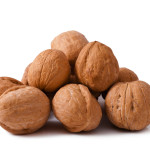Walnuts, the oldest tree food known to man are believed to have come from ancient Persia and were traded between Asia, the Middle East, and far off lands, making the Walnut one of the most popular nuts in the world.
While grown in many countries around the world, California, with its mild climate and deep fertile soils, provides ideal growing conditions for the English walnut, produces 99% of the total U.S. crop and 2/3 of the world’s trade. The walnut is a versatile ingredient nut. In manufactured food products, walnuts positively impact product flavor, texture, mouth feel, nutritional value, and stability. Walnuts are extremely functional in a wide variety of food processes: freezing, baking, broiling and roasting.
Walnuts are sorted into 8 sizes. Walnuts are sized over round hole screens expressed in 1/64î. These sizes range from 12/64î to 52/64.
Shelled Walnuts Packaging Options
As a general rule, pieces and halves are available in 25 lb. corrugated boxes with or without poly-lined bags. Smaller kernel sizes are usually available in 30 lb. boxes. Suppliers also ship in 1,000 to 2,000 lb. containers, #10 tins, and other industrial sizes.
Sizing | |
|---|---|
| Walnut Halves | 7/8 or more of the kernel is intact. 85% or more of lot, by weight, are half kernels with the remainder three-fourths half kernels. |
| Walnut Pieces and Halves | 20% or more of lot, by weight, are half kernels (7/8 or more of the kernel is intact). |
| Walnut Pieces | Portions of kernels in lot cannot pass through 24/64 inch round opening. |
| Walnut Medium Pieces | Although not covered in USDA Standards, Medium Pieces are a common size classification used in the California walnut industry. No less than 98% may pass through a 32/64-inch screen. |
| Walnut Small Pieces | Portions of kernels in lot pass through 24/64 inch round openings but cannot pass through a 8/64 inch round opening. |
| Walnut Meal | The smallest form of the walnut comes in various consistencies ranging from a coarse meal to a fine powder. Use walnut meal to dust cakes, use in dough and batter, and for walnut compounds. Finely ground walnut are incorporated into pastas, added to fillings and used as a thickening agent in sauces. |
| Topping Pieces | Portions of lot pass through 20/64 inch round opening. |
| Syrupers | Portions of lot pass through 28/64 inch round opening. |
GRADING | |
|---|---|
| Extra Light | No more than 15% shall be darker than extra light. |
| Light | No more than 15% shall be darker than light. |
| Light Amber | No more than 15% shall be darker than light amber. |
| Amber | No more than 10% shall be darker than amber. |
In-shell Walnuts – From the orchard to your table
According to USDA standards “inshell walnuts” are processed in several sizes:
- Jumbo
Large
Medium
* In-shell walnuts are packaged in 50 lb.
Storage
Walnuts should be stored in low moisture (55 – 65% relative humidity) and low temperature (32° – 28° F or 0° – 3.3° C) conditions. Keep walnuts away from excessive heat, moisture, light, and odors to ensure maximum shelf life and freshness



